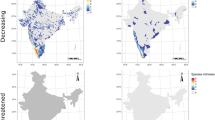Abstract
The breakdown of species integrity was studied in three sympatricSatyrium (Orchidaceae) species at a site in the Western Cape province of South Africa. Hybrids with intermediate morphology were identified using multivariate analysis.Satyrium erectum ×S. bicorne andS. erectum ×S. coriifolium hybrids were common, while only oneS. bicorne ×S. coriifolium hybrid was found (a new record). Reciprocal artificial crossing experiments confirmed that genetic compatibility exists between all three species. However, the species have different pollinators: moths inS. bicorne, bees inS. erectum and sunbirds inS. coriifolium. Pollinators, rather than genetic factors, therefore, appear to be responsible for reproductive isolation between these species. Breakdown in pollinator specificity results in interspecific pollen transfer and the formation of hybrids. Overlap in floral signals, including nocturnal scent in bothS. erectum andS. bicorne, and bright coloration in bothS. erectum andS. coriifolium, facilitates the formation of hybrids between these species pairs. The brown, scented flowers ofS. bicorne, on the other hand, share no obvious floral signals with the bright orange, unscented flowers ofS. coriifolium, accounting for the rarity of hybrids between this species pair. Differences in floral morphology also result in mechanical isolation between these two species. Since the three species are sympatric in a very small part of their geographic ranges, it is unlikely that avoidance of hybridization has been an important selective factor in the evolution of specialized pollination systems.
Similar content being viewed by others
References
Bolus H. (1913) Icones orchidearum Austro-Africanarum extra-tropicarum; or figures, with descriptions, of extra-tropical South African orchids. Wesley & Son, London.
Brantjes N. B. M. (1981) Wind as a factor influencing flower visiting byHadena bicruris (Noctuidae) andDeiliphila elpenor (Sphingidae). Ecological Entomology 6: 361–363.
Cowling R. M., Richardson D. M., Mustart P. J. (1997) Fynbos. In: Cowling R. M., Richardson D. M., Pierce S. M. (eds.) Vegetation of Southern Africa. Cambridge University Press, U.K., pp. 99–131.
Dobzhansky T. (1937) Genetics and the origin of species, 1st edn. Columbia Univ. Press, New York.
Dressler, R. L. (1981) The orchids: natural history and classification. Harvard University Press, Cambridge, Mass.
Dressler R. L. (1993) Phylogeny and classification of the orchid family. Dioscorides, Portland.
Duthie A. V. (1917) On hybrid forms in the genusSatyrium, with descriptions of two new forms. Transactions of the Royal Society 6: 289–297.
Garside S. (1922) The pollination ofSatyrium bicallosum. Thunb. Ann. Bolus Herb. 2: 149–152.
Gill D. E. (1989) Fruiting failure, pollinator inefficiency, and speciation in orchids. In: Otte D., Endler J. A. (eds.) Speciation and its consequences. Sinauer Associates Inc., USA, pp. 458–481.
Grant V. (1949) Pollination systems as isolating mechanisms in angiosperms. Evolution 3: 82–97.
Grant V. (1994) Modes and origins of mechanical and ethological isolation in angiosperms. Proceedings of the National Academy of Science USA 91: 3–10.
Hall A. V. (1982) A Revision of the southern African species ofSatyrium. Contr. Bolus Herb. 10: 1–142.
Johnson S. D. (1996) Bird pollination in South African species ofSatyrium (Orchidaceae). Plant Syst. Evol. 203: 91–98.
Johnson S. D. (1997a) Insect pollination and floral mechanisms in South African species ofSatyrium (Orchidaceae). Plant Syst. Evol. 204: 195–206.
Johnson S. D. (1997b) Pollination ecotypes ofSatyrium hallackii (Orchidaceae) in South Africa. Botanical Journal of the Linnean Society 123: 225–235.
Johnson S. D. (1997c) Pollination, adaptation and speciation models in the Cape flora of South Africa. Taxon 45: 59–66.
Kurzweil H. (1995) Floral morphology and ontogeny in in subtribe Satyriinae (fam. Orchidaceae). Flora 190: 1–20.
Levin D. A. (1970) Reinforcement of reproductive isolation: Plants versus animals. Amer. Naturalist 104: 571–581.
Levin D. A. (1971) The origin of reproductive isolating mechanisms in flowering plants. Taxon 20: 91–113.
Mayr E. (1963) Animal species and evolution. Harvard Univ. Press, Cambridge.
Nilsson L. A. (1983) Processes of isolation and introgressive interplay betweenPlantanthera bifolia (L.) Rich andP. chlorantha (Custer) Reichb. (Orchidaceae). Botanical Journal of the Linnean Society 87: 325–350.
Nilsson L. A. (1992) Orchid pollination biology. Trends in Ecology and Evolution 7: 255–259.
Peakall R., Bower C. C., Logan A. E., Nicol H. I. (1997) Confirmation of the hybrid origin ofChiloglottis X pescottiana (Orchidaceae: Diurideae). 1. Genetic and morphometric evidence. Australian Journal of Botany 45: 839–855.
Pijl L. Van Der, Dodson C. H. (1966) Orchid flowers: their pollination and evolution. University of Miami Press, Coral Gables.
Statsoft (1995) STATISTICA for Windows (Volume III): Statistics 2. Statsoft Inc, USA.
Stebbins G. L. (1950) Variation and evolution in plants. Columbia Univ. Press, New York.
Stebbins G. L. (1984) Mosaic evolution, mosaic selection and angiosperm phylogeny. Botanical Journal of the Linnean Society 88: 149–164.
Steiner K. E., Whitehead V. B., Johnson S. D. (1994) Floral and pollinator divergence in two sexually deceptive South African orchids. American Journal of Botany 81: 185–194.
Templeton A. R. (1989) The meaning of species and speciation: A genetic perspective. In: Otte D., Endler J. A. (eds.) Speciation and its consequences. Sinauer associates Inc., USA, pp. 3–27.
Vogel S. (1959) Organographie der Blüten kapländischer Ophrydeen. Akad. Wiss. Lit. Math. Naturwiss. Kl. (Mainz) 6–7: 1–268.
Author information
Authors and Affiliations
Rights and permissions
About this article
Cite this article
Ellis, A.G., Johnson, S.D. Do pollinators determine hybridization patterns in sympatricSatyrium (Orchidaceae) species?. Pl Syst Evol 219, 137–150 (1999). https://doi.org/10.1007/BF00985575
Received:
Accepted:
Issue Date:
DOI: https://doi.org/10.1007/BF00985575




